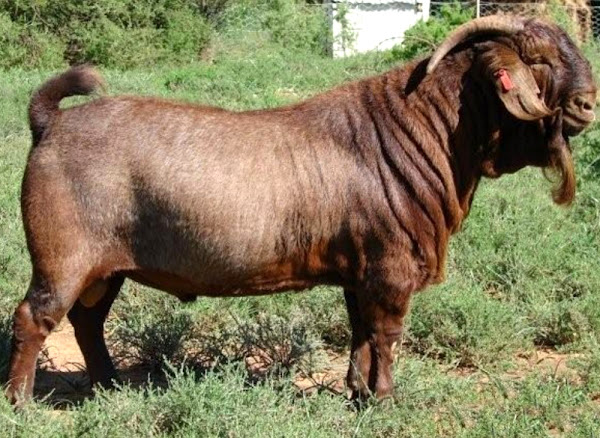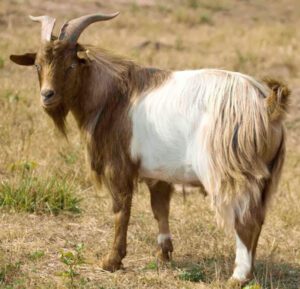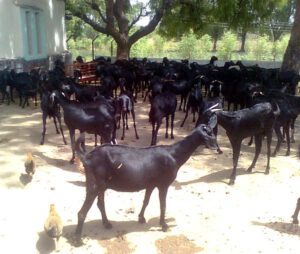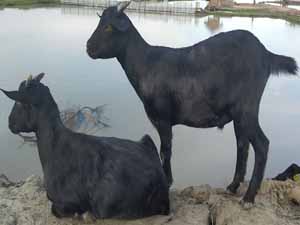Commercial Kalahari Red goat farming business is becoming popular gradually. The Kalahari Red is among the best meat goat breeds and it’s popularity is increasing throughout the world.
The Kalahari Red goat originated from South Africa. And actually many high quality and very productive meat goat breeds have been developed from South Africa. The Boer and Savana goats are already world famous breed and the Kalahari Red goat is becoming popular gradually.
The Kalahari Red goats have many similarities with the Boer goat breed, and many people believe that the ‘Kalahari Red goats’ are related to or may have derived from the Boer goats. This is mainly because of their Boer like appearance.
But this is not true, and the Kalahari Red goat is a distinct and separate breed of domestic goat. Compared to Boer goats, the Kalahari Red goats are very hardy and their meat is more tender then the meat of Boer goat.
Today in South Africa, the Kalahari Red goats are considered as an very important goat breed, and they are raised mainly for meat production. And major populations of Kalahari Red goats outside South Africa are in Australia, Brazil and United States.
How to Start Kalahari Red Goat Farming?
The Kalahari Red is a meat goat breed. And commercial Kalahari Red goat farming business is just like starting and operating any other meat goat breeds.
Most important steps for starting and operating Kalahari Red goat farming business are purchasing good quality animals, making a good shelter for them, providing them with good foods and taking good care of them. Here we are trying to discuss more about all these steps.
Step 1. Purchase Goats
First of all, purchase good quality and healthy goats for starting Kalahari Red goat farming business. You can purchase goats from any of your local farms or existing livestock markets. Also consider searching your local online classified websites.

Step 2. Housing
Making a good shelter or house for your goats is important. Their shelter or house is the place where they will stay and spend most of their times. The Kalahari Red goats generally prefer dry and clean shelter just like many other domestic goat breeds.
So making a raised house (which is above from the ground) is a good idea for Kalahari Red goat farming business. Raised house are very easy to clean and it always remains dry. Although you can raise them in deep litter system if you don’t have enough facilities for making a raised house.
Ensure good ventilation system so that enough light and fresh air can enter inside the house. And make the house in such a way so that you can clean the house easily. As a large sized breed, around 15 square meter housing space will be enough for each goat. Although you will need to arrange a separate playing ground for your animals if you want to raise them in stall fed system.
Step 3. Feeding
Feeding the animals with good quality and nutritious food is the most important part of Kalahari Red goat farming business. Good food not only helps to grow the animals happily, but also helps to keep them healthy. So, always try to feed your goats with nutritious foods.
The goats also require vitamins and minerals. Contact a vet in your area for better recommendation about this. And always try to provide your goats with enough clean and fresh water as per their demand. Read more about what to feed meat goats.
Step 4. Breeding
The Kalahari Red goats are naturally very good breeders. And generally natural breeding is practiced for Kalahari Red goat farming, instead of artificial breeding. Generally one healthy buck is able to breed 25-35 does.
Step 5. Caring
Along with providing good shelter and quality foods, the Kalahari Red goats also require additional caring. Vaccinate and de-worm the goats timely and try to keep them free from all types of parasites.
Thus you will be able to keep your goats healthy. And contact a vet immediately if you notice anything wrong.
Step 6. Marketing
Marketing goat products is actually not a problem. You will probably be able to easily sell your products in your local market. Although you should set your marketing strategies before starting Kalahari Red goat farming business.
These are the common steps for starting and operating a successful Kalahari Red goat farming business. Good luck and may God bless you!







Does anyone know of any US breeders of Kalahari Reds?